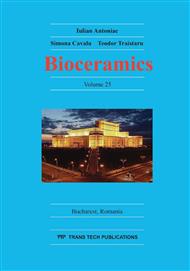p.315
p.321
p.325
p.331
p.338
p.343
p.349
p.356
p.360
The Micro CT Evaluation of Different Types of Matrices in Rats Bone Augumentation
Abstract:
Introduction. The osteoconductive materials are very important in the bone regeneration procedures. The aim of this paper is to evaluate the interface between the old bone and the new regenerated one.Materials and methods. Ten rat femurs were used for this investigation. Under strict supervision, ten holes were drilled in the rat femurs and then filled with Bio-Oss® (Geistlich, Wolhusen, Switzerland). matrix. The samples were obtained after 3 month from the procedure and were investigated by MicroCT. A common Synchrotron Radiation X-Ray micro-CT experiment was performed at the SYRMEP Beamline of the ELETTRA Synchrotron Radiation Facility (Trieste, Italy). The 900 radiographic projections were acquired with a beam energy of 29 keV over 180° (0.2 degrees step) with a resolution of 9μm. A sample – detector distance of 16 cm was considered. The tomographic reconstruction was performed by means of the common filtered back-projection method. The 3D reconstructions were obtained at the University of Ancona using specific software, VGStudio Max.Results: The synchrotron offered 900 microCT files that were used to make the 3D reconstruction of the bone. After tomographic reconstruction, 3D renderings of obtained data may be made by electronically stacking up the slices. These 3D volumes may be also sectioned in arbitrary ways, zoomed and rotated in order to locate better the individual details. While the 2D slice images and 3D renderings are very useful for making qualitative observations of an internal concrete structure, the real benefit is the quantitative information that can be extracted from the 3D datasets.The reconstructions allow observing the normal rat bone, the new regenerated bone and also the rest of nonactivated matrix of Bio-Oss® (Geistlich, Wolhusen, Switzerland). The system permits to make measurements in order to quantify the volume of the new bone formation and also the status of the bone defect, in order to define the healing process.Conclusions: The MicroCT method proves to be an important imagistic tool for nondestructive evaluation of the interface between the new regenerated bone and the old one from the rat femurs. This method allows numerical quantification of the new regenerated bone and define the healing bone process.
Info:
Periodical:
Pages:
338-342
Citation:
Online since:
November 2013
Keywords:
Price:
Сopyright:
© 2014 Trans Tech Publications Ltd. All Rights Reserved
Share:
Citation:


